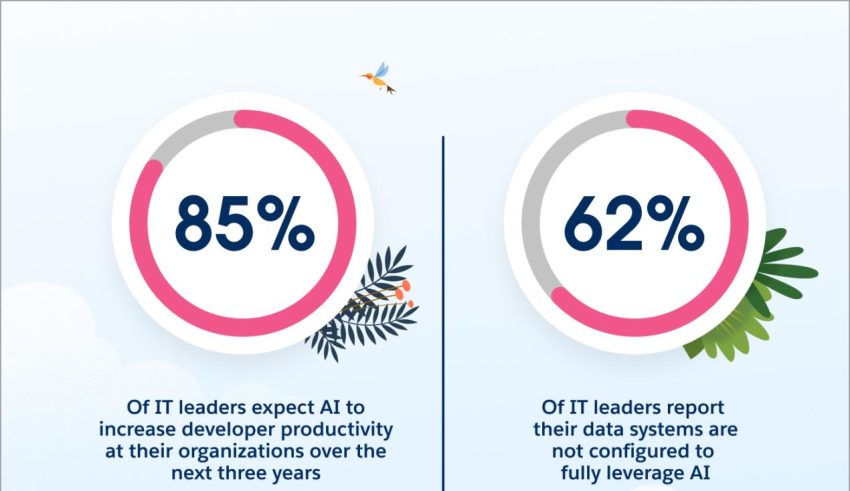
News Desk
DUBAI: New Salesforce research shows 85% of IT leaders expect AI to increase developer productivity at their organizations over the next three years — a welcome relief as they simultaneously report a 39% increase in IT requests in the last year alone. However, 62% also say their organization isn’t yet equipped to harmonize data systems to fully leverage AI, which is impeding the transition and further heightening the strain on their teams.
Adding to these concerns, 98% of IT organizations today report experiencing at least some degree of challenge with their digital transformation efforts, with 80% citing data silos as a concern and 72% grappling with systems that are overly dependent on one another.
MuleSoft’s annual Connectivity Benchmark Report surveyed 1,050 CIOs and IT decision makers around the world to understand these challenges and how organizations can use integration, automation, and APIs to build successful AI strategies.
Successful AI strategies that drive ROI and business value hinge on integrating and unifying data
Successful AI strategies rely heavily on strong data integration strategies in order to reap the benefits of improving operational efficiency, productivity, and employee and customer experiences.
- AI is the bellwether: IT leaders expect a 69% increase in the average number of Large Language Models (LLMs) they’ll use over the next three years, with 80% of organizations reporting they already use multiple predictive and generative AI models today.
- Integration is a primary hurdle to AI innovation: While AI drives efficiency and productivity, it is dependent on integrated data. However, only an estimated average of 28% of apps are connected and 95% of IT leaders report integration issues are impeding AI adoption.
- Security, trust remain as barriers to adoption: 64% of IT leaders are concerned with ethical AI usage and adoption.
Breaking down data silos can unlock AI’s full potential and provide a seamless user experience
Data silos are significant barriers to progress and business value, with 81% of respondents reporting that silos are hindering digital transformation efforts. As a result, there’s a greater need for better integration to unify all structured and unstructured business data to power and deploy trusted, relevant AI across all business functions.
- Organizations are challenged to connect data with AI applications: 72% of IT leaders find their current infrastructure overly interdependent, with 62% reporting their organization is not equipped to harmonize their data systems to leverage AI technologies.
- Data insights go untapped: 75% of organizations say they’re struggling with integrating data insights into user experiences.
- Digital customer experiences aren’t fully baked: Only 26% of organizations believe they provide a completely connected user experience across all channels.
Automation is essential as business users seek self-sufficiency, yet overburdened IT teams largely hold the keys
IT teams are often responsible for automation adoption, but remain cautious to allow business stakeholders to self-serve — only 22% of IT leaders report that their strategy to help non-technical business users integrate apps and data sources via APIs is up to date. Simultaneously, a skills gap within IT teams poses a hurdle. Closing this gap through strategic collaboration and upskilling is essential for organizations to best use automation for both innovation and efficiency.
- IT teams are under immense pressure: IT teams are struggling to integrate efficiently, as 98% report facing challenges regarding digital transformation. Skills gaps and compliance concerns top the list of IT challenges.
- AI can help IT teams’ performance: 85% of IT leaders expect AI to boost developer productivity.
- IT teams use Robotic Process Automation (RPA) to ease the burden: IT teams are increasingly adopting automation to manage high demands, with one in three teams now preferring RPA, a notable rise from 13% in 2021 to 31% in 2023.
Virtually every company runs on APIs, and they can be a strategic lever for growth
APIs streamline data access and utilization to fuel growth by seamlessly connecting different applications and systems. In fact, an estimated 33% of all revenue is from API and API-related offerings — APIs account for one-third of revenue, a number that has remained steady over the past three years.
- Revenue potential is unleashed with APIs: APIs have contributed to increased revenue for 39% of respondents — and decreased operational costs for 35%.
- APIs boost operational efficiency, enhancing productivity: IT leaders report that APIs increase agility and promote self-service (54%), increase productivity (48%), and benefit business teams by helping them meet their demands (46%).
- APIs are in demand: A majority (54%) of IT leaders are using APIs to build integrations.
Salesforce perspective: “AI is only as powerful as the data organizations can connect to it and the outcomes they can drive from it. Fundamentally, these are integration and automation challenges organizations are facing. This data shows IT leaders are increasingly aware that their ability to operationalize AI — and drive business and customer value — will be dependent on their ability to integrate it with their existing systems to create new opportunities for growth.” – Param Kahlon, EVP and GM, Automation and Integration












